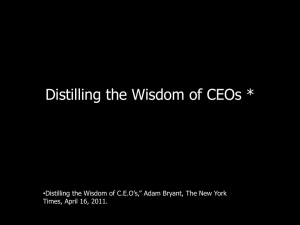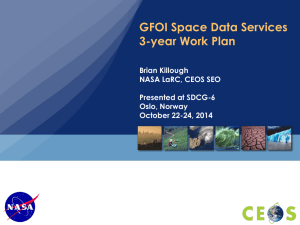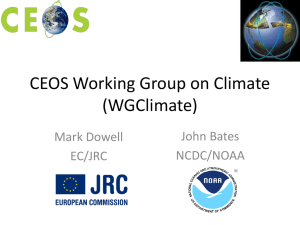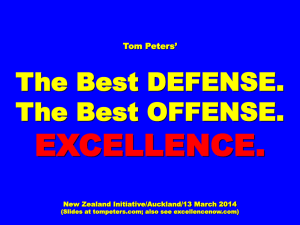response document
advertisement
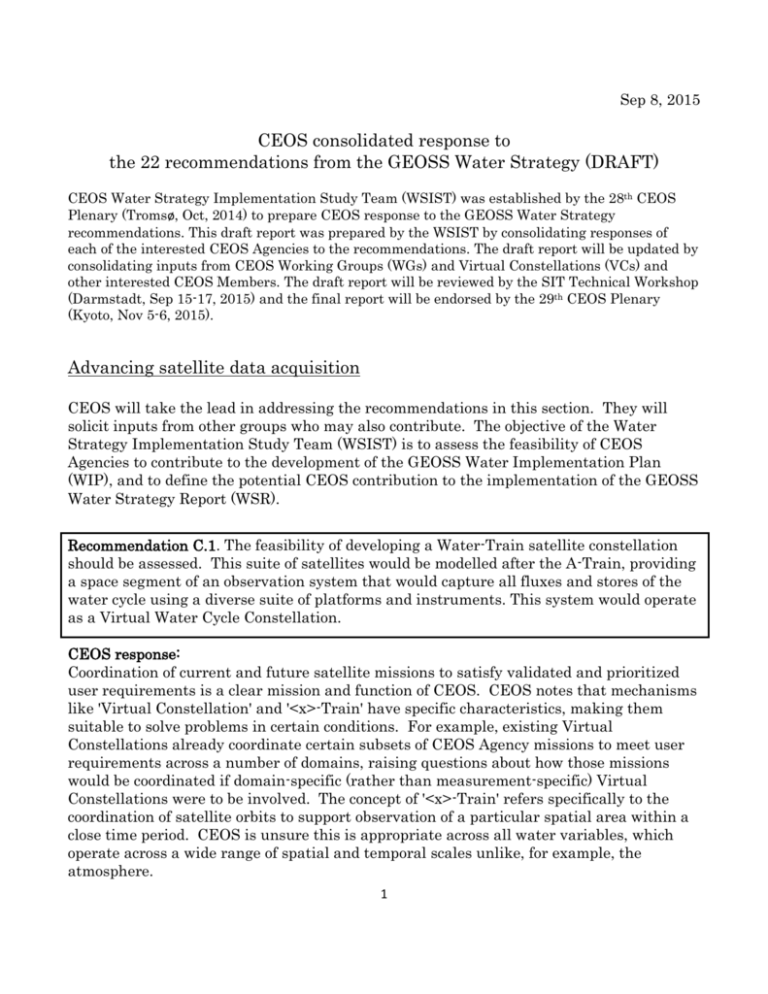
Sep 8, 2015 CEOS consolidated response to the 22 recommendations from the GEOSS Water Strategy (DRAFT) CEOS Water Strategy Implementation Study Team (WSIST) was established by the 28th CEOS Plenary (Tromsø, Oct, 2014) to prepare CEOS response to the GEOSS Water Strategy recommendations. This draft report was prepared by the WSIST by consolidating responses of each of the interested CEOS Agencies to the recommendations. The draft report will be updated by consolidating inputs from CEOS Working Groups (WGs) and Virtual Constellations (VCs) and other interested CEOS Members. The draft report will be reviewed by the SIT Technical Workshop (Darmstadt, Sep 15-17, 2015) and the final report will be endorsed by the 29th CEOS Plenary (Kyoto, Nov 5-6, 2015). Advancing satellite data acquisition CEOS will take the lead in addressing the recommendations in this section. They will solicit inputs from other groups who may also contribute. The objective of the Water Strategy Implementation Study Team (WSIST) is to assess the feasibility of CEOS Agencies to contribute to the development of the GEOSS Water Implementation Plan (WIP), and to define the potential CEOS contribution to the implementation of the GEOSS Water Strategy Report (WSR). Recommendation C.1. The feasibility of developing a Water-Train satellite constellation should be assessed. This suite of satellites would be modelled after the A-Train, providing a space segment of an observation system that would capture all fluxes and stores of the water cycle using a diverse suite of platforms and instruments. This system would operate as a Virtual Water Cycle Constellation. CEOS response: Coordination of current and future satellite missions to satisfy validated and prioritized user requirements is a clear mission and function of CEOS. CEOS notes that mechanisms like 'Virtual Constellation' and '<x>-Train' have specific characteristics, making them suitable to solve problems in certain conditions. For example, existing Virtual Constellations already coordinate certain subsets of CEOS Agency missions to meet user requirements across a number of domains, raising questions about how those missions would be coordinated if domain-specific (rather than measurement-specific) Virtual Constellations were to be involved. The concept of '<x>-Train' refers specifically to the coordination of satellite orbits to support observation of a particular spatial area within a close time period. CEOS is unsure this is appropriate across all water variables, which operate across a wide range of spatial and temporal scales unlike, for example, the atmosphere. 1 However, CEOS notes the value of establishing and implementing appropriate coordination mechanisms to support monitoring of the water cycle. CEOS therefore proposes to respond to this recommendation by undertaking a study to identify what axes of coordination (spectral, spatial, temporal) would ultimately translate into the production of information with the biggest impact on society. For example, such a study would examine whether increasing spatial and temporal coverage of specific important water cycle variables such as evapotranspiration is of higher relevance to users than coordinated observations. Such a study would take into account current capabilities and their associated spatial and temporal characteristics, as well as capabilities likely for future planned and potential satellite systems. This would include consulting with the full range of CEOS Members. CEOS notes that a number of existing and proposed missions, including specialist missions (such as GPM) and more general missions (such as ALOS, SMOS/SMAP, Sentinel-2 or Landsat) have potential to contribute to a coordinated solution. Such a study would take particular care to ensure proposals drew on, and reinforced the need for, data from current and future operational platforms. Such a study would also identify where gaps and overlaps in existing measurements could be addressed to better optimise to meet water requirements, in order to minimse the need for new missions. Such a study will also consider how next-generation geostationary missions could contribute in addressing temporal frequency of observations without the need for new polar orbiting missions implied by an '<x>-Train' approach. CEOS will also ensure this study links with the study proposed in its response to C10. CEOS notes that it will be necessary to have clear guidance from end users about the procedures they need to apply to integrate data streams for each of the relevant variables before determining what the priorities for coordination would be and the most appropriate coordination mechanism (such as a new Virtual Constellation). This input should be provided by GEO IGWCO, following consultation with CEOS to ensure the information collected will be sufficient for the purpose. Proposed CEOS action for C1:CEOS to undertake a feasibility study on enhanced coordination of satellite missions, data acquisition and product generation to support an integrated approach to water monitoring. Terms for action: Near-term 2015-2017 CEOS lead entity: WSIST (One year extention of the WSIST will be proposed to conduct the FS) CEOS contributing entities: P-VC(TBC), LSI-VC(TBC), SEO 2 Proposed external partnership: WMO, CGMS, IGWCO C.2. Satellite missions such as those in the A-Train and the planned EarthCare and GCOM-W2 missions and field experiments should be closely coordinated to measure cloud properties, with the goal of providing data for the study of precipitation processes and energy budgets. Furthermore, these satellite measurements should be transitioned into operations and sustained in the long term. CEOS response: CEOS agrees with statements that the water and energy cycles are coupled in many ways, and recommends that this recommendation be expanded to include coincident measurement of relevant radiation fluxes (i.e., those significantly impacted by cloud presence and type). CEOS Agencies have expressed their ability to contribute data from a range of missions with relevance to this recommendation, including VIIRS, CRIS, ATMS and EarthCare. CEOS notes that this coordination between field experiments and satellite observations already occurs in many cases, to support existing calibration/validation campaigns. CEOS seeks further clarify from the GEO IGWCO on additional coordination requirements, and will then be in a position to provide an indication of ability to support study goals. CEOS notes that a range of the relevant missions are run in accordance with long term / fixed acquisition plans, and welcomes ongoing dialogue with the GEO IGWCO on how to operate in this context. CEOS notes that issues of provision of satellite measurements on an operational basis is a question for individual Members and their governments, but that the ability to explain how a particular mission would form part of a coherent international satellite observing system is a powerful input to funding decisions. CEOS further notes that the successful application of data from non-operational programs to deliver results to influential users, and effective communication of the impact and relevance of those applications by those users to key decision makers, is an important step in transitioning research missions into operational programs. This would be an area where CEOS would greatly welcome the support of the GEO IGWCO in working with user communities. CEOS Agencies have identified the potential to supply relevant field data, for example from international networks of surface flux towers, to complement better coordinated space data. 3 CEOS notes that Ralph Ferraro/NOAA submitted input to the GEO transitional 2016 Work Plan on Water Vapor and Clouds (and Aerosol and Precipitation) activity. The primary objective of this activity is to develop an observation strategy to improve the synergistic understanding between water vapor and clouds, and if feasible, aerosols and precipitation. Proposed CEOS action for C2: CEOS to participate in the GEO water vapor and cloud activity which was proposed by Ralph Ferraro/NOAA. Terms for action: 2016 CEOS lead entity: P-VC(TBC) CEOS contributing entities: Proposed external partnership: WMO, CGMS, IGWCO C.3. Advanced satellite technologies, such as hyperspectral infrared and millimetre/submillimetre and microwave radiometers, should be promoted to improve horizontal and vertical resolutions of key measurements to observe clouds, water vapour, and aerosols. As well, multi-frequency radars should be sustained and Doppler capabilities should be introduced to observe the cloud precipitation particle continuum and provide vertical velocities for critical cloud-process studies. CEOS response: CEOS Agencies have a number of existing and planned missions that will generate datasets which will, together, substantively address this recommendation in the medium term. The EarthCARE/CPR mission is anticipated to be launched in 2015 or shortly thereafter, and will provide precipitation measurement capabilities for snow and ice. CEOS Agencies are developing advanced global water vapour retrievals (total column with 350m and 1km resolution), and aerosol retrievals (AOD and aerosol properties at 3km and 1 km resolutions) for the Sentinel-3 (low-earth orbit) and Sentinel-4 (geostationary) missions. CEOS notes that the Precipitation Virtual Constellation is conducting a study to analyse plans post-GPM. A number of CEOS Agencies have already expressed in-principle commitment to GPM and other satellite related activities that will support his goal - both for precipitation processes, clouds, and the role of aerosols with both. CEOS also notes that JPSS/CrIS sensor will fly on J-1 and J-2. CEOS also notes that the Ice Cloud Imager (ICI) covering the sub-mm wave range, IASING a Microwave Imager (MWI) and 3MI will fly on the EPS-SG platforms in the 2020 4 time frame. CEOS believes these will provide novel observing capabilities for operational polar satellites which complement the established and continued microwave and thermal IR humidity soundings. The suite of complementary payloads on the Second Generation Polar System are expected to provide a sustained pillar which could be complemented with specific research instrument missions. The Lightning Imager (LI) on MTG will provide new capability to detect deep convective cloud systems. Although CEOS believes that this combination of missions will substantively address the requirements underpinning this recommendation, CEOS notes a possible gap in the area of operational multi-frequency radar but this is under consideration by post-GPM system study being led by NASA and JAXA. CEOS would welcome dialogue with the GEO IGWCO on how to ensure the need is apparent to key decision makers. Proposed CEOS action for C.3: same with C.2 Terms for action: 2016 CEOS lead entity: P-VC(TBC) CEOS contributing entities: Proposed external partnership: WMO, CGMS, IGWCO C.4. The coverage and quality of satellite observations should be improved to a constellation providing three-hourly (or more frequent) revisit times over the entire globe by a combination of GMI/AMSR2-class multi-channel conically scanning microwave imagers and ATMS-class multi-channel cross-track microwave sounders. These instruments are identified because they provide input data for a wide range of applications. CEOS response: Current GPM observations includes GMI/AMSR-2, ATMS and SAPHIR plus the DMSP instruments and the recommendation has been already realized in a substantive sense. The CEOS Precipitation Virtual Constellation is coordinating the GPM constellation and its improvement of coverage and observation quality. The Precipitation Virtual Constellation is studying the post GPM mission, including three frequency precipitation radar. CEOS notes and supports that a number of missions are planned, or under consideration. These missions include ATMS on J-1 and J-2, AMSR-2 follow-on on GCOM-W2, W-COM and two conical scanners and a cross track MW sounder to be flown on EPS-SG. 5 CEOS notes that further study would be required, led by the GEO IGWCO, to determine what the science and downstream user communities would get from having the 8-12 AMSR2/GMI type instruments in space that would be required to address this recommendation. The coverage of the tropics thanks to low-inclined orbit missions should be evaluated in detail since after the demise of TRMM it is now only operated by the SAPHIR sounder on board the Megha-Tropiques mission (already in extended life operation). Such a study should pay particular attention to anticipated downstream economic benefit, cost of establishing the relevant space and ground segments, and clarification of the aspects of the water cycle that would be left under-observed. CEOS notes that there are positive synergy in enabling these study to be realized in cooperation with the WMO/CGMS International Precipitation Working Group CEOS will also conduct a study to consider the option of emulating the TRMM multisatellite precipitation analysis (TMPA) system for soil moisture. Such an approach would involve multiple polar orbiting and geostationary satellites calibrated to the reference instrument(s) on a core soil moisture satellite mission. The possibility to deliver increased spatial resolution (< 1-km), as well as increased temporal resolution, may have greater relevance to agricultural production which is of high, and growing, policy relevance. CEOS notes that the Soil Moisture Operational Products System (SMOPS) of NOAA combines soil moisture retrievals from multi-satellites/sensors to provide a global soil moisture map with more spatial and temporal coverage (http://www.ospo.noaa.gov/Products/land/smops/). CEOS supports the idea of having a better sampling in spatio and temporal domains of soil moisture using passive microwave at low frequency on polar orbits. CEOS notes that George Huffman/NASA plans to develop a white paper on precipitation and coordination with P-VC is ongoing. Proposed CEOS Action for C4: CEOS to participate in the development of the white paper on precipitation which George Huffman/NASA will lead. Terms for action: 2016 CEOS lead entity: P-VC(TBC) CEOS contributing entities: TBD Proposed external partnership: WMO, CGMS, IPWG, IGWCO 6 C.5. Space-borne precipitation radar should be made operational and next-generation precipitation radar with advanced technology should be developed. The success of the TRMM precipitation radar has demonstrated that space-borne radar observations are among the most valuable multi-purpose observations of precipitation. Although the GPM Dual-frequency Precipitation Radar is expected to extend this result, a long-term plan is needed for using these radars operationally and a long-term commitment is needed by GEO members to ensure a continuity of supply for these instruments. CEOS response: Precipitation Virtual Constellation is studying post GPM mission, including three frequency precipitation radar (Ku, Ka and W bands). In the study, long-term strategy for the precipitation radar and precipitation mission will be developed. It is useful to note that potentialities of assimilating SMOS/SMAP data to improve rainfall estimates derived from GPM series of satellites. CEOS notes that issues of provision of satellite measurements on an operational basis is a question for individual Members and their governments, but that the ability to explain how a particular mission would form part of a coherent international satellite observing system is a powerful input to funding decisions. CEOS further notes that the successful application of data from non-operational programs to deliver results to influential users, and effective communication of the impact and relevant of those applications by those users to key decision makers, is an important step in transitioning to an operational basis. This would be an area where CEOS would greatly welcome the support of the GEO IGWCO in working with user communities. GEO support and GEO member commitments will be requested to ensure continuity of supply for these instruments. Proposed CEOS action for C.5: same with C.4. Terms for action: 2016 CEOS lead entity: P-VC(TBC) CEOS contributing entities: TBD Proposed external partnership: WMO, CGMS, IGWCO 7 C.6. A commitment by CEOS, GEO, and their members to provide requisite thermal band imaging sensors on satellites is needed. Routine Land Surface Temperature (LST) observations at high spatial/low temporal (e.g., LANDSAT), moderate spatial/temporal (e.g., MODIS), and low spatial/high temporal (e.g., GOES, Meteosat, and other geostationary platforms) are essential in order to improve ET estimation from the field to the continental and, ultimately, to the global scale. Responsible agencies need to process and make available LST datasets from GEO satellites so that these products can be used to map ET in near-real time. More frequent revisit times (four-day) along with higher resolutions (finer than 100 metres) through multiple LANDSAT-type satellites are needed to compensate for data loss from clouds and water management requirements. CEOS response: Numerous CEOS members are actively engaged in the development and improvement of LST estimation methods and products. At high spatial resolution, NASA and USGS are supporting studies to exploit Landsat thermal data to produce calibrated LST for improved ET estimation. NASA is considering deployment of a Landsat-like thermal sensor (2019) to ensure continuity of such measurements. CNES in a cooperative framework (NASA/JPL, ISRO) is currently defining a high spatial resolution/high revisit mission (60m, 3 days) in the TIR dedicated to agricultural and natural ecosystems water stress, and to coastal and inland waters monitoring. At moderate to low spatial, but higher temporal resolution, EUMETSAT provides LST information from Meteosat and Metop in near real time and NOAA operationally distributes real-time LST products from S-NPP VIIRS and GOES. Both organizations plan continued production of LST (e.g., from J-1, J-2, GOES-R and additional Metop missions). And the status of JAXA GCOM-C with SGLI is “Approved” with plans to launch in 2016 or thereafter. ESA is developing advanced global LST algorithms that will provide 1km measurements with a daily geographical repeat rate when Sentinel-3a and b are in orbit in 2017/2018. CEOS notes that research into new techniques for LST measurement, fusion of in situ and multi-resolution satellite data and remote sensed ET estimation itself is needed before this recommendation can be fully realized. For example, greater leveraging of data from polar and geostationary data may yield higher spatial and temporal resolution products. LST data assimilation in process based models may suggest different approaches to measuring LST are needed to track ET. Furthermore, a greater focus on quality control, especially cloud screening, is required for geostationary LST observations. A number of CEOS Agencies have expressed their commitment to research, develop and employ calibration and processing techniques that yield the highest quality LST observations allowed by system performance and available resources. Further CEOS notes that the Land Surface Imaging Virtual Constellation has identified the coordination 8 and optimization of LST contributions from CEOS agencies in support of confirmed/validated requirements for ET estimation as a key priority. CEOS respectfully suggests that the demand for real-time provision of well-calibrated LST at fine spatial resolution (e.g., Landsat) should be carefully assessed as meeting it would require significant and sustained additional investment. CEOS notes that the GEO IGWCO should progress efforts to improve ground networks (in accordance with D.2) for cloud and atmospheric water vapour to ensure there is confidence across users and governments that current, and proposed, satellite investment by CEOS Members are effective. Proposed CEOS action for C.6: CEOS to coordinate its LST missions towards improved ET estimation. Terms for action: Ongoing to Near term 2015-2017 CEOS lead entity: LSI-VC (TBC) CEOS contributing entities: WGCV (TBC) Proposed external partnership: WMO, CGMS, GTOS C.7. GEO and CEOS should facilitate the planned NASA/German Aerospace Centre (DLR) joint GRACE II mission that will follow the current GRACE Twin (expected launch date of August 2017). GRACE II is expected to provide improved accuracy and resolution due to technological advances made during the past decade. It is essential for ensuring continuity of the many GRACE applications that have emerged. The U.S. National Research Council’s Decadal Survey Study’s call for a continuation of GRACE follow-on missions with lower-orbit, drag-free satellites with laser interferometry that yield higher spatial resolution data is also a priority for GEO. CEOS response: CEOS Agencies are supporting the next GRACE system, Grace follow-on (expected launch ~2017), which will demonstrate some improvements resulting from technological improvements as recommended. 9 CEOS suggests that the underlying issues are the need for better groundwater (or total water) change detection. Improved ranging from laser interferometry and moving to a drag-free design would be helpful, and is being explored. However, factors to consider in the overall algorithmic approach, such as influences from atmospheric pressure and ocean circulation, and the need to couple the data with accurate estimates of snow, ice, soil moisture and vegetation water content, and CEOS will encourage Agencies to consider in their longer-term plans. CEOS Agencies will require additional input from the user community, and additional resources, to study this issue comprehensively. CEOS will require enhanced engagement from the relevant GEO initiatives and bodies to deliver on this. Proposed CEOS action for C.7: This recommendation has been already implemented and no new CEOS action is required. Terms for action: NA CEOS lead entity: NA CEOS contributing entities: Proposed external partnership: WMO, CGMS, IGWCO C.8. Plans for a mission optimized to measure cold season processes and variables from space drawing on experience with algorithms for cold season microwave measurements and cold season field projects should be developed. CEOS response: CEOS notes that supporting information in the GEOSS Water Strategy implies that this goal is aimed at freeze/thaw patterns, snow cover, snow water equivalent, and snow pack properties. CEOS notes that freeze-thaw aspects are addressed in the response to C.9. CEOS is confident that this is being addressed. CEOS notes that agencies have multiple satellites operational and planned to give information on snow cover and water equivalent, as well as discern types of falling precipitation. Studies and field campaign activities are planned to further assess the capability of future satellite systems to improve observations of snow, in particular SWE, in more areas at enhanced spatial resolutions and with better accuracy. 10 Proposed CEOS action for C.8: The recommendation has been already addressed by CEOS agencies and no new CEOS action is required. Terms for action: NA CEOS lead entity: NA CEOS contributing entities: Proposed external partnership: WMO, CGMS, GCOS, IGWCO C.9. Attention should be given to the further development of multichannel satellite sensors that will be able to provide freeze/thaw patterns under different vegetation conditions. CEOS response: CEOS notes the importance of understanding these patterns. Data from a range of current, planned, and considered CEOS missions and instruments, such as GCOM-C (vegetation conditions), SMOS, ASCAT, SMAP (surface freeze/thaw state), AirMOSS-P (Freeze/Thaw boundaries) and BIOMASS, AMSR-2, will support work in this area. CEOS further notes that CEOS Agencies have supported research in this area. CEOS suggests that the GEO IGWCO more clearly articulate the measurements required, which will help identify any specific gaps and opportunities in current and planned measurements including merging datasets (see E.1). Proposed CEOS action for C.9: The recommendation has been already addressed by CEOS agencies and no new CEOS action is required unless additional observation requirements are identified. Terms for action: ONA CEOS lead entity: NA CEOS contributing entities: Proposed external partnership: WMO, CGMS, IGWCO 11 C.10. A feasibility assessment should be undertaken to determine the benefits and technological difficulties of designing a hyperspectral satellite mission focused on water quality measurements. CEOS response: CEOS will undertake a high-level feasibility assessment of the benefits and technological difficulties of designing a hyperspectral satellite mission focused on inland, estuarine, deltaic and near coastal waters as well as mapping macrophytes, macro-algae, seagrasses and coral reefs at significantly higher spatial resolution than 250m. CEOS notes that new information has emerged from the GEO Water Quality community in recent months that alternative approaches, involving augmenting designs of spaceborne sensors for terrestrial and ocean colour applications to allow improved inland, near coastal waters and benthic applications, could offer an alternative pathway to addressing the same underlying science questions. Accordingly, CEOS will also analyse the benefits and technological difficulties of this option as part of the high-level feasibility study. CEOS will also examine the potential of establishing threshold and baseline observation requirements for sensors suitable for water quality applications. This information will inform CEOS Agencies when considering the potential to adapt their sensors so they add this relevant application area to their mission designs. CEOS notes that funding for dedicated missions, or for enhancing or adapting mission designs, is a decision for individual agencies and governments. CEOS recommends that the GEO Water community commence the process of defining inland and near-coastal and benthic habitat essential variables for water quality. CEOS recommends that this analysis should include a rigorous assessment of relative priority, linked to defined economic, social and environmental benefits. This information would be of great value in informing investment decisions. Proposed CEOS action for C.10: CEOS to make a high-level feasibility study on a hyperspectral satellite mission focused on water quality measurements. Terms for action: Near-term 2015-2017 CEOS lead entity: WSIST CEOS contributing entities: LSI-VC (TBC), OCR-VC(TBC) Proposed external partnership: GEM, GEO Task WA-01-C4 and WA-01 IGWCO, IOCCG Strengthening in-situ data acquisition 12 CEOS will, consistent with its mission and objectives, support other in-situ organizations to address the recommendations in this section. D.2. A global observational network dedicated to clouds and water vapour should be established. This network should include high-calibre radiosonde stations (some collocated with Baseline Surface Radiation Network stations, others in critical areas lacking such data, particularly equatorial zones), GPS, and lidars. These observations should be freely available to the scientific community. CEOS response: CEOS supports the notion of continued support to such networks (many already established through CEOS Agencies and other activities under CGMS, WMO, etc.) but urges the operators to make the data available to the scientific community. D.5. A strong rationale should be developed in order to encourage increased financial commitments by GEO members and other nations to continuous operation and expansion of soil moisture networks. A strategy reviewing the optimum network size and trade-offs between the number of stations and equipment upgrades and demonstrating the benefits of soil moisture in key applications would be part of this rationale. The strategy should also review the benefits of supersites; the full spectrum of environmental variables would be measured. Support is also needed for follow-on missions such as GCOM-W2, which are necessary to provide long-term global soil moisture measurements. CEOS response: CEOS notes its support for the development of a strong rationale for any Earth observation-enabled initiatives, and the importance of such a rationale in securing increased financial commitments. CEOS requests further coordinated efforts by the insitu and space communities for the development of Standard Operation Procedures, network calibration best practices, etc. CEOS would be willing to support this work on a best-efforts basis. It should be noted that soil moisture networks are useful only under specific conditions especially wrt spatial and temporal coverage and harmonisation. Some efforts are made (see ISMIN) but the target is still not at hand. Specific studies to quantify representativity are needed but one should note that the soil moisture missions did start addressing the issue in their Cal/Val programmes (SMOS and SMAP). Cosmic ray proves are very interesting and have a significant areal representativity (~800m) but correspond to vaiable significant depth and are affected by varying vegetation cover. 13 CEOS notes its contribution under C4 in relation to satellite sensing of soil moisture, including GCOM-W2, SMOS Folow on or W-COM which are under consideration.. (Rick to confirm that GEWEX is producing strategy/rationale) Proposed CEOS action for D.5: CEOS to notes its support for the development of a strong linkage of crucial sensors enabling long time monitoring of essential variables. It thus fully supports any Earth observation-enabled initiatives and stresses the importance of such a rationale in securing increased financial commitments. A joint programme leading to an operational soil moisture satellite product based on SMOS/SMAP track record seems a strong case to promote as it provides a global homogeneous and uniform set of soil moisture fields. Terms for action: Ongoing CEOS lead entity: NA CEOS contributing entities: Proposed external partnership: WMO, CGMS, GCOS, GTN-H, GEWEX, IGWCO Encouraging and conducting research and product development E.1. Research on individual-sensor and multi-sensor algorithms should be supported. Operationally useful estimates from individual sensors over complex terrain, icy/snowy surfaces, coast, and land (in general) are priorities that require substantial development work. Improved algorithms for the objective, optimal combination of precipitation observations from widely disparate sources must see continued research and development, potentially including assimilation approaches. Conversely, as an additional initiative, combinations incorporating both observations and numerical model/reanalysis estimates should be supported. This action should particularly benefit polar and cool-season midlatitude regions, since the numerical results tend to validate better in those conditions. CEOS response: CEOS Agencies confirm that they are engaged in several R&D activities (some of which have led to operational products) that are paving the way for multi-sensor precipitation products. A wide range of techniques have been used to date, although the use of NWP model information is likely limited at this stage. Continued international coordination through various precipitation working groups (i.e., CGMS/IPWG and CEOS/P-VC) is encouraged, where much of state-of-the-art techniques are discussed, intercompared, etc. 14 E.5. High priority should be given to generating improved global soil texture maps in order to improve modelling and retrieval of soil moisture. Furthermore, a more concerted effort is needed to develop an integrated soil moisture product. CEOS response: CEOS Agencies will continue to support programs with the aim of verifying and validating national forest and land cover change. A range of existing data types are under-used in characterising soil texture, and CEOS would encourage the GEO IGWCO to evaluate how existing data types (such as SAR) could be optimally used. CEOS notes that numerous activities exist across the world and those should be closely coordinated, in particular with the Global Terrestrial Observation System (GTOS) GOFC-GOLD panel (http://www.fao.org/gtos/gofc-gold/index.html). CEOS notes that soil texture data are required for soil moisture retrieval algorithms, and that without this information the value of satellite soil moisture observations can not be fully realised. Currently, the data used by the soil moisture and land surface modeling communities are from the data sets of Reynolds, Jackson and Rawls (1999, WRR) which is based on FAO soil map of the world. CEOS notes there is significant opportunity to improve these and therefore improve soil moisture algorithms and/or land surface models. (7/27 mail from Xiwu Zhang, NOAA) Proposed CEOS action for E.5: CEOS to notes the importance of generating improved global soil texture map in order to improve modeling and retrieval of soil moisture and to coordinate to develop integrated soil moisture product. CEOS to define its soil texture map requirements, and communicate them to IGWCO. Terms for action: Near-term 2015-2017 CEOS lead entity: WSIST CEOS contributing entities: WGCV (TBC) Proposed external partnership: WMO, CGMS, GCOS, FAO, IGWCO 15 E.7. A dataset including all bathymetry of all surface water bodies around the globe should be developed, possibly under the leadership of UN Water. CEOS response: CEOS notes that a range of existing, planned and considered satellite missions provide datasets that could help provide the backbone for such an effort. CEOS notes that for inland waters and coastal and coral reef areas with permanently water covered areas spectral inversion methods and stereophotogrammetric methods can be applied using high (< 30 m) and mid spatial (~ 30 m ) resolution satellite imagery. CEOS further notes that for water bodies with temporarily exposed areas rating curves and advanced statistics applied to long term mid to high spatial resolution archives can provide digital elevation models. CEOS Agencies are also exploring techniques that mine the long time-series of moderateresolution satellite data, using semi-analytical spectral inversion methods and advanced statistics, to develop DEMs and shallow-water bathymetry products at continental-scales with potential applicability to global scale. CEOS agrees there is value in exploring opportunities to integrate all these different approaches to maximise the value of existing satellite data. CEOS suggests that a global approach will require global agreement on methodology to obtain a reliable consistent bathymetry product, requiring coordination amongst a range of stakeholders. CEOS would be willing to contribute to such an activity, if appropriately lead and coordinated. CEOS notes that there is GEO foundational activities to address this issue (TBC). Proposed CEOS action for E.7: CEOS to support any external activities to define methodology to develop global bathymetry of surface waters. Terms for action: CEOS lead entity: TBD CEOS contributing entities: TBD Proposed external partnership: GTN-H, GEO 16 E.8. The feasibility of establishing a monitoring system of man-made reservoirs should be developed. The end result of this review could be the use of current and planned data systems to provide a real-time monitoring system of the surface water in storage. CEOS reponse: A variety of groups within the remote sensing community have been researching methods to identify surface water bodies (including lakes and reservoirs) and monitor their areal extent over time. Efforts to estimate and monitor their volume require information on both bathymetry (see recommendation E.7) and stage (i.e., water surface height). The capability to monitor stage reliably through satellite remote sensing is scale/resolution dependent. The planned NASA/CNES SWOT mission (2020 estimated launch date) will provide information on stage for lakes and reservoirs of sufficient size. Research on SWOT algorithm development, calibration and validation across a wide variety of environments and scales is being supported in the interim. Additional discussion of requirements and specification is necessary to address this and related recommendations. CEOS members commit to participation in a GEOSS user or working group formulated to define a global framework for reservoir monitoring. Coordination of such CEOS involvement would be led by CNES. (Any USGS update ? ) (USGS) The USGS is investigating the use of Landsat to systematically monitor the extent of surface waters at high spatial resolution. While these measurements in themselves to not provide absolute information on storage, they can be used to index changes in storage conditions and, in combination with other satellite or in situ data, can be used to estimate and monitor surface water in storage. ) Proposed CEOS action for E.8: CEOS to participate in GEO activities to define a global framework for surface water monitoring. Terms for action: Near-term 2018-2020 CEOS lead entity: CNES for SWOT appplications (TBC) CEOS contributing entities: TBD 17 Proposed external partnership: GWSP, WMO, IGWCO E.9. An initiative should be launched to assess the feasibility of combining in-situ measurements and GRACE satellite data to produce an integrated groundwater product on a regional basis. CEOS response: CEOS Agencies have and will continue to explore combining GRACE information with other in situ and satellite observations through data assimilation techniques and land surface modeling to produce enhanced groundwater assessments. Information will be made available to GEO and the water cycle community through peer review publications on achieved capabilities and limitations of current approaches. It is thought that the enhanced assessment will have some utility to the water management community, albeit still limited due to the coarse nature of observations available from GRACE. Proposed CEOS action for E.9: CEOS will continue to explore combining GRACE information with in-situ observations as part of its routine activity. Terms for action: Ongoing CEOS lead entity: NASA and DLR (TBC) CEOS contributing entities: TBD Proposed external partnership: WMO, CGMS, Earth2Observe E.10. Priority should be given to research on the development of algorithms and new sensors to measure the water equivalent of snow on the ground under a wide range of vegetation conditions. Furthermore, it may be possible to design improved algorithms to more effectively utilize existing data sources. CEOS response: CEOS notes that Agencies are considering missions/programs dedicated to advance the measurement of snow properties from space, and opportunities to generate a suite of snow products as part of their baseline programs. CEOS Agencies are also involved in dedicated field campaigns focussed on snow and ice to help validate satellite measurements. Proposed CEOS action for E.10: CEOS to note ongoing activities on the development of algorithms and new sensors to measures the water equivalent of snow. 18 Terms for action: Ongoing CEOS lead entity: NA CEOS contributing entities: CEOS agencies with snow monitoring mission Proposed external partnership: WMO, CGMS, GCOS E.11. An initiative should be launched to develop a research-quality dataset of the climatology of snow properties, initially regionally, and eventually globally, integrating insitu, microwave, and visible snow measurements. Efficient ways should be found for distributing the data among all interested researchers. CEOS response: CEOS notes that several CEOS Agencies are engaged in such activities, although coordination to date is limited to WMO's GCW program (who could potentially lead this effort). Additionally, the WCRP CliC can be considered, although much like GCW, there is no coordination on this activity. CEOS agencies are generating products in response to GCOS ECV’s which includes snow cover/properties.(TBC) Proposed CEOS action for E.11: CEOS to note ongoing activities to develop a researchquality dataset of the climatology of snow properties. Terms for action: Ongoing CEOS lead entity: WGClimate (TBC) CEOS contributing entities: WGCV (TBC) Proposed external partnership: WMO, CGMS, GCOS, WCRP Facilitating data sharing and common standards 19 F.1. Institutions maintaining archives of water cycle variables should apply modern standards of open data stewardship. High-quality products require consistently processed, long-term datasets that are readily available, preferably including one version in the original coordinates (for example, swath-footprint for satellite data). As new qualitycontrol procedures and algorithms are developed, these archives should be reprocessed to ensure that the community has ready access to consistently processed estimates for the entire period of record. CEOS response: CEOS is committed to improving the discoverability and accessibility of data and products, and enhancing the application of data stewardship principles, within and across Agency programmes. These efforts are led by the Working Group on Information Systems and Services (WGISS), who have published a range of best practice guides linked to broader GEO activities and principles. This group is now working closely with agencies to embed these best practice guides into internal systems, and has made significant progress through initiatives such as the IDN, FedEO and CWIC. A number of CEOS Ad-hoc Teams, working with WGISS, are exploring next-generation architectures for the exploitation of very large volumes (multi-petabyte scale) of satellite data using advanced statistical techniques and high performance computing. Such architectures also have significant potential to enable the water community to better harness existing and future satellite missions, and combine satellite data with in-situ data, potentially delivering products based on existing or planned missions rather than requiring specific new satellites. Discussion with the GEO IGWCO on this issue would be welcome. CEOS Virtual Constellations, and many individual CEOS Agencies, have protocols in place to reprocess datasets. CEOS acknowledges challenges of data reprocessing and its significant impact on resources. CEOS is open to discussions with the GEO IGWCO on opportunities to improve and better coordinate reprocessing protocols and campaigns. CEOS notes the importance of having clear provenance chains from the sensor to the enduser products for certain applications, particularly those feeding into regulatory processes. Proposed CEOS action for F.1: CEOS to continue to improve the discoverability and accessibility of data and products and enhancing the application of data stewardship principles. Terms for action: Ongoing CEOS lead entity: WGISS (TBC) 20 CEOS contributing entities: CEOS agencies Proposed external partnership: WMO, CGMS, GTN-H F.6. GEO should develop plans to ensure that vitally needed telecommunications infrastructure be established in order to ensure data availability in the developing world and to support the transmission of high-volume satellite datasets during the coming decades. CEOS response: CEOS notes that this recommendation is directed to GEO. CEOS will consider how to support this recommendation once GEO develops plans for infrastructure of data availability. CEOS does, however, refer again to its response to F1 noting the potential for next-generation data architectures (where users go to the data) may be a key part of the solution to use of very large data sets. CEOS notes that new approaches, such as cloud computing and the CEOS DataCube platform, offer significant potential to ameliorate the problems historically caused by low bandwidth. The ability to ‘bring users to the data’ should be fully explored and exploited, as it may be more feasible than building high-speed links capable of sustaining many Terabytes of data transfer a day. Moreover, in many cases telecommunication link capacity is only one factor, with the ability to store, retrieve, process and analysis very large space datasets also lacking. Proposed CEOS action for F.6: No CEOS action is required. Terms for action: NA CEOS lead entity: NA CEOS contributing entities: NA Proposed external partnership: NA Expanding capacity development CEOS will, consistent with its mission and objectives, support other agencies to address the recommendations in this section 21 G.3. Periodic GEO Water Strategy capacity-building workshops should be convened, without specific geographical focus, to develop a broad strategy for GEO Water capacitybuilding. These workshops should focus on developing synergies between the work done in different geographical areas, a means for more effectively transferring the results from one region to another, and common training materials that can be used in different geographical areas. CEOS response: This recommendation is directed to GEO, not CEOS. CEOS space agencies will consider participation in planned GEO Capacity Building Workshops, as they are planned. Proposed CEOS action for G.3: CEOS to contribute to the proposed GEO Water Strategy capacity-building workshops as part of core business. Terms for action: Ongoing CEOS lead entity: NA CEOS contributing entities: WGcapD (TBC) Proposed external partnership: WMO, CGMS, UNESCO, GEO Although not listed in the 22 recommendations CEOS may also wish to provide input on: The following two recommendations were cited later by the IGWCO CoP leader as those may be relevant for CEOS to address. A.1. A study of the methods for assessing the requirements and needs of users should be undertaken by identifying precisely how different observational data types and derived information products end-applications sectors are used in decision-making tasks. Based on the results of this study, an analysis should be carried out to design the best available integrated observing technology and data analysis systems that deliver data products in a form that satisfies the input requirements of the end-user decision-making process. This would entail some well-designed workshops, with strong representation of the user community. CEOS response: 22 SEO is suitable contact point for information about missions and products, while user requirements are coordinated by and come from IGWCO. A.3. A global-scale coordinated initiative should be developed and implemented to advance the future use of satellite remote sensing for water quality applications. Factors such as the community requirements for continuity of existing satellites, development of new and improved sensor/platform technology, algorithm development, calibration/validation activities, and improvements in open and free data accessibility should be part of this initiative. CEOS response: CEOS notes that this recommendation is already being progressed through the GEO Global Water Quality Community of Practice, with participation from a range of CEOS Agencies. CEOS notes that IOCCG is developing the IOCCG report on global water quality monitoring. Proposed CEOS action for A.3: CEOS to consider its involvement when further information on the global water quality framework becomes available. Terms for action: Ongoing CEOS lead entity: TBD CEOS contributing entities: CEOS agencies with water color mission Proposed external partnership: GEO task WA-01-C4 and WA-01 IGWCO (task number in 2016 GEO work program need to be confirmed 23
